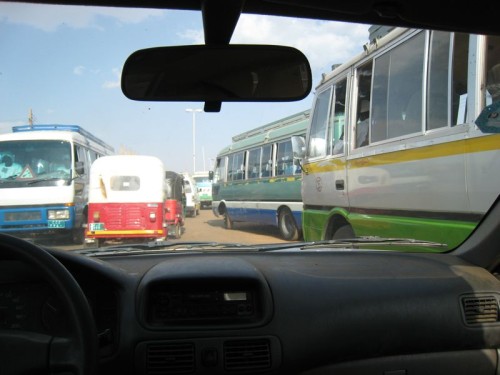
There is another facet of driving in the Sandbox that I didn’t include in my prior post. Namely, honking 3 -5 seconds before the light turns green. It can be disconcerting that one is getting honked at when the light is red and nothing can be done, but over time I have better understood what is going on in this situation. Let me try to explain some of my observations and the subsequent implications. First, let me start with a random photo of driving in the Sandbox (click to enlarge), then onto the observations.
Observation 1: Stoplights are not suspended above intersections as is common in the US. Neither are they mounted on the far side of the street, as would be common in the US should they not be suspended. Instead, stoplights are often mounted about 10 feet back from the intersection on the same side as the traffic is coming from. In my estimation, the traffic police did not want cars crowding the intersection. Again, references to “The Creep” and “The Pack” can attest to the issues that arise from crowded intersections.
Observation 2: If a car stops at the stoplight (10 feet before the intersection), then other cars will move around your vehicle to be positioned in front of it. Sometimes driving over curbs, sometimes just inching, inching, inching. It is a subtle thing, but if you daydream for a minute at the stoplight after you have stopped, you will “wake up” to find that you are not the first one at the stop light any more. Now, I don’t have a need to rush around everywhere, but especially if I am trying to turn left and only 2 cars can make it in one left turn signal, it is frustrating to have been the “first one” in line only to then be the 3rd one in line and not make it through the intersection! The concepts of “staying in line” is something that is not inherently as big of a Sandbox value as it is in the US.
Observation 3: The “lead” car (that is well in front of the stoplight) cannot see when the light turns green. This means when it does turn green, often the lead car will not move for 5 seconds as he is slow to realize it is his turn to start moving. This may limit the number of cars that can turn left to 1 instead of 2 or 3.
Observation 4: Cars behind the lead car that can see the stoplight will start honking when there are 3 – 5 seconds remaining of the red light. In this way the lead car without the ability to know when the light will turn green is informed that he needs to be ready for action.
In this way, the “community” has overcome the attempts by the traffic police to not “crowd” intersections through “strategic” stoplight placement. It takes more than “technology” to correct driving habits.
– Mr. Rikshaw
